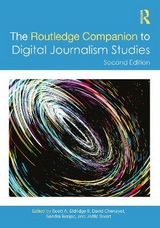
The Routledge Companion to Digital Journalism Studies
Routledge (Verlag)
978-1-138-88796-1 (ISBN)
- Lieferbar
- Versandkostenfrei
- Auch auf Rechnung
- Artikel merken
Across the last decade, journalism has undergone many changes, which have driven scholars to reassess its most fundamental questions, and in the face of digital change, to ask again: ‘Who is a journalist?’ and ‘What is journalism?’. This companion explores a developing scholarly agenda committed to understanding digital journalism and brings together the work of key scholars seeking to address key theoretical concerns and solve unique methodological riddles.
Compiled of 58 original essays from distinguished academics across the globe, this Companion draws together the work of those making sense of this fundamental reconceptualization of journalism, and assesses its impacts on journalism’s products, its practices, resources, and its relationship with audiences. It also outlines the challenge presented by studying digital journalism and, more importantly, offers a first set of answers.
This collection is the very first of its kind to attempt to distinguish this emerging field as a unique area of academic inquiry. Through identifying its core questions and presenting its fundamental debates, this Companion sets the agenda for years to come in defining this new field of study as Digital Journalism Studies, making it an essential point of reference for students and scholars of journalism.
Bob Franklin is Professor of Journalism Studies at the Cardiff School of Journalism, Media and Cultural Studies. He is the founding editor of the journals Digital Journalism, Journalism Practice and Journalism Studies. His most recent book is The Future of Journalism: In an Age of Digital Media and Economic Uncertainty (2015). Scott A. Eldridge II is an Assistant Professor of Journalism Studies and Media at the University of Groningen, Netherlands. His research and publications focus on changing concepts of journalism and the challenges to journalism’s identity presented by emerging digital actors. He is Reviews Editor for the journal Digital Journalism and is on the editorial boards of Digital Journalism and the Journal of Applied Journalism & Media Studies.
Introduction; 1: Conceptualizing digital journalism studies; 1: What’s Digital? What’s Journalism?; 2: Deconstructing Digital Journalism Studies; 3: Digital Journalism Ethics; 4: The Digital Journalist; 5: The Time(s) Of News Websites; 6: Digital Footage from Conflict Zones; 7: Gatekeeping and Agenda-Setting; 2: Investigating digital journalism; 8: Rethinking Research Methods for Digital Journalism Studies; 9: Automating Massive-Scale Analysis Of News Content; 10: The Ethnography of Digital Journalism; 11: Investigating ‘Churnalism’ In Real-Time News; 12: Digital Journalism and Big Data; 13: Exploring Digital Journalism With Web Surveys; 3: Financial strategies for digital journalism; 14: Funding Digital Journalism; 15: Resourcing A Viable Digital Journalism; 16: Newspaper Paywalls And Corporate Revenues; 17: Computational Journalism and The Emergence Of News Platforms; 18: Crowdsourcing in Open Journalism; 19: Community and Hyperlocal Journalism; 4: Digital journalism studies: Issues and debates; 20: Mobile News; 21: Digital Journalism And Tabloid Journalism; 22: Automated Journalism; 23: Citizen Journalism; 24: User Comments And Civility On Youtube; 25: Digital Transparency And Accountability; 5: Developing digital journalism practice; 26: Data, Algorithms, and Code; 27: Self-Referential Practices in Journalism; 28: Live Blogs, Sources, and Objectivity; 29: Follow The Click?; 30: Journalists’ Uses of Hypertext; 31: Computer-Mediated Creativity and Investigative Journalism; 6: Digital journalism and audiences; 32: Making Audience Engagement Visible; 33: Constructing News with Audiences; 34: Revisiting the Audience Turn in Journalism; 35: Between Proximity and Distance; 36: Audiences and Information Repertoires; 37: The Spatiotemporal Dynamics Of Digital News Audiences; 7: Digital journalism and social media; 38: Transformations of Journalism Culture; 39: Social Media and Journalism; 40: Twitter, Breaking The NEWS, and Hybridity in Journalism; 41: Journalists’ Uses of Twitter; 42: Facebook and NEWS Journalism; 43: The Solo Videojournalist as Social Storyteller; 8: Digital journalism content; 44: Converged Media Content; 45: Newspapers and Reporting; 46: The New Kids On the Block; 47: Longform Narrative Journalism; 48: Photojournalism and Citizen Witnessing; 49: Developments in Infographics; 9: Global digital journalism; 50: Social Media Transforming News; 51: Social Media and Radio Journalism in South Africa; 52: A Conundrum of Contras; 53: Data Trumps Intuition Every Time 1; 54: Social Media Use, Journalism, and Violence In The Northern Mexico Border; 55: Newsroom Convergence; 10: Future directions; 56: Whistleblowing in A Digital Age; 57: Surveillance In A Digital Age; 58: Epilogue: Digital Journalism
| Erscheinungsdatum | 25.05.2016 |
|---|---|
| Reihe/Serie | Routledge Journalism Companions |
| Zusatzinfo | 9 Tables, black and white; 16 Halftones, black and white; 16 Illustrations, black and white |
| Verlagsort | London |
| Sprache | englisch |
| Maße | 174 x 246 mm |
| Gewicht | 1224 g |
| Themenwelt | Sozialwissenschaften ► Kommunikation / Medien ► Allgemeines / Lexika |
| Sozialwissenschaften ► Kommunikation / Medien ► Journalistik | |
| Sozialwissenschaften ► Kommunikation / Medien ► Medienwissenschaft | |
| ISBN-10 | 1-138-88796-X / 113888796X |
| ISBN-13 | 978-1-138-88796-1 / 9781138887961 |
| Zustand | Neuware |
| Informationen gemäß Produktsicherheitsverordnung (GPSR) | |
| Haben Sie eine Frage zum Produkt? |
aus dem Bereich



